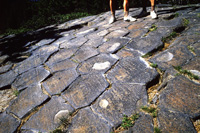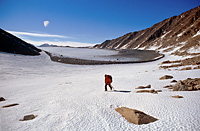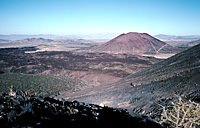
Cosmonauts
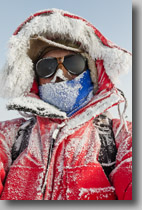
John Stone Group leader [1] [2]
Geologist, ion tamer and professor in the Department of Earth and Space Sciences. My PhD research was on the geochemistry of helium and the other noble gases, followed by brief stints working on lunar soils and isotopically unusual, pre-solar grains in meteorites. A chance encounter with baffling He-3/He-4 ratios in the late 1980s led me to cosmic ray produced nuclides and their use in geomorphology and exposure dating. This has become the core of my research.
With students and collaborators, I am working on projects in Antarctica, some aimed at dating the last glaciation, others concerned with the long-term history of the ice sheet. Additional interests include the geochemistry and geomorphology of cratonic landscapes, erosion and sediment transport in the Pacific northwest, and integration of cosmogenic nuclides into geomorphic models. The projects and publications listed elsewhere on this website provide further information.
I've long been involved in chasing down the details of cosmogenic nuclide production, both at the surface and deep below ground. For the last few years I've been an active participant in the CRONUS-Earth project, an NSF-sponsored effort to do just that. Our CRONUS page contains more information and useful data from the project.
I teach geology and geochemistry, but if you're looking for information about that, please refer to my class web pages.

Zach Ploskey PhD student
I am broadly interested in geomorphology, glacial geology and the use ofcosmogenic nuclides to understand landscape evolution during the Quaternary.I hope to shed light on the spatial patterns of landscape change beneath icesheets and explore novel applications of cosmic ray-produced isotopes to understand earth surface processes.
Currently I am working on several projects relating to cosmogenic nuclides. One that I am very excited about is using cosmogenic nuclide depth profiles to estimate erosion rates beneath glaciers and ice sheets. Other projects include dating the retreat of the Vashon Ice Sheet from Puget Sound through the San Juan Islands and the timing and rate of latest-Pleistocene retreat of glaciers in the Convict Creek drainage in the Sierra Nevada of California.

Perry Spector PhD student
My scientific interests lie in the past and present interactions between geomorphology, the cryosphere, and climate variability. By quantifying the spatial and temporal patterns of geomorphological change, I hope to better understand the surface processes governing landscape evolution in glaciated regions. Currently, I am researching the deglaciation chronology of the Transantarctic Mountains since the last glacial maximum by using a combination of glacial geology and cosmogenic nuclide exposure dating. Read more on my research website.
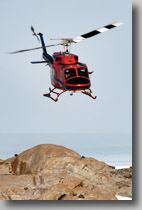 Trevor Hillebrand Graduate student
Trevor Hillebrand Graduate studentGlacial geologist and trumpet maestro.
Knows all the words to Bohemian Rhapsody.
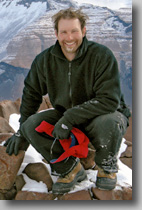
Dave Argento PhD student
As unlikely as it seems, Dave's passion for nuclear physics, rocks, beer and photography have all come together in his research at the Earth & Space Sciences Department of the University of Washington. Using a radiation transport code, MCNPX, and massive amounts of CPU time, Dave has been modeling the cosmic radiation cascade from the top of the atmosphere, all the way down into the rocks and ocean underneath. These simulations provide a cost effective method for exploring characteristics of the radiation cascade that have been difficult or impossible to measure in detail (such as the angular distribution and energy spectrum of the neutron flux) . This characterization of the radiation is part of a physics-based complement to geological calibration of cosmogenic nuclide production rates, and should lead to better production rate estimates and better correction procedures for exposure dating and erosion-rate measurements. Some projects applying this methodology are:
(i) Developing nuclide-specific altitude-latitude scaling schemes, by combining model neutron and proton spectra with excitation functions for different cosmogenic nuclides.
(ii) Investigating boundary effects for neutron-capture and high-energy reactions.
(iii) Developing methods to recover complex exposure-erosion histories and paleo-altitude from depth profiles and multiple-nuclide measurements.
During the weeks it takes to complete simulations, Dave is occasionally found brewing beer for departmental parties or building up his photography portfolio [surely "reading the physics and geology literature, completing papers and assisting with labwork"? JS].
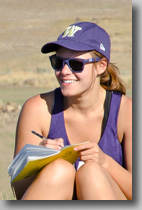
Danielle Lemmon Undergrad student, chemist and mineralogist
Danielle is really a physicist, but returns to the group each summer for new adventures in geology. She has worked on chlorine-36 chemistry, the long-term glacial history of Antarctica and the Missoula floods in eastern Washington. She is now expert at finding glacial polish on granite boulders.
Does not yet know all the words to Bohemian Rhapsody.
Former Cosmonauts
 Clay Johnson Former ESS undergraduate and lab
assistant
Clay Johnson Former ESS undergraduate and lab
assistantCurrently I am pursuing a BS degree in Earth and Space Sciences while working with the Cosmogenic Isotope Group. I look forward to applying the skills/knowledge that I learn here toward the good of mankind (no one likes a mad scientist), hopefully in the form of a better understanding of glaciology, landscape evolution, and isotope geochemistry.
I've been working in southern Puget Sound to sample and date large glacial erratics from the terminal moraine of the Vashon Ice Sheet.
Clay is now completing a Masters degree in Applied Geomorphology.
...


